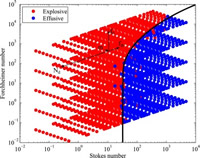Numerical investigation of permeability models for low viscosity magmas: Application to the 2007 Stromboli effusive eruption
La Spina G., M. Polacci, M. Burton, M. de’ Michieli Vitturi (2017).
Earth and Planetary Science Letters, 473/1, 279-290, https://doi.org/10.1016/j.epsl.2017.06.013.
Abstract
Magma permeability is the most important factor controlling the transition between effusive and explosive styles during magma ascent at active volcanoes. When magma permeability is low, gas bubbles in the melt expand as the pressure decreases; above a critical gas volume fraction threshold, magma fragments, generating an explosive eruption. On the contrary, if magma is sufficiently permeable, gas ascends through the conduit towards the surface faster than the magma ascent speed, producing decoupling of gas and magma and reducing the maximum vesicularity. This decoupled flow inhibits fragmentation and leads to either an effusive eruption or quiescent degassing. Accurate modelling of permeability behaviour is therefore fundamental when simulating magma ascent processes. In this work, we compare different permeability models for low viscosity magmas using a 1D steady-state model. We use, as a test case, the 2007 effusive eruption at Stromboli volcano, Italy. We compare the numerical solutions computed using the linear Darcy’s law with those obtained using the non-linear Forchheimer relation. Our numerical results show that, using Darcy’s law and appropriate permeability models, it is possible to obtain an effusive eruption in agreement with observations. However, we found that, in the shallow conduit, the limit of applicability of Darcy’s law (that is the modified Reynolds number Rem < 10) is exceeded due to high gas flow rates. Furthermore, we show that using Forchheimer’s law and some parametric expressions for viscous and inertial permeabilities, results can be compatible with an effusive eruption, once appropriate values are chosen. However, one of the parameters required to obtain an effusive eruption, the friction coefficient between gas and melt, is several orders of magnitude lower than that determined from measurements of solid erupted samples. This result requires further experimental verification. We propose that our novel permeability modelling regime is suitable for basaltic volcanism. We highlight that permeabilities derived from studying solid samples are not representative of the actual permeability of a molten magma, at least in the case of low viscosity basaltic magmas. These findings have fundamental implications for the quantification of permeability, modelling of volcanic processes and volcanic eruption dynamics, and the forecasting of volcanic eruptions.
https://www.sciencedirect.com/science/article/pii/S0012821X17303229


